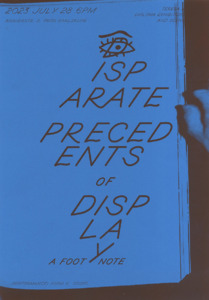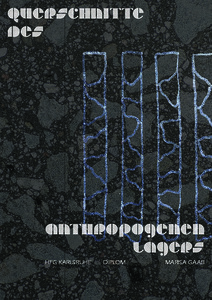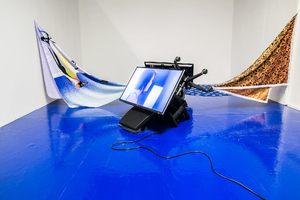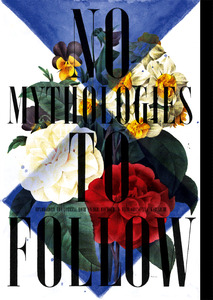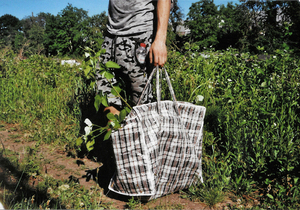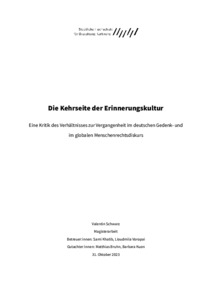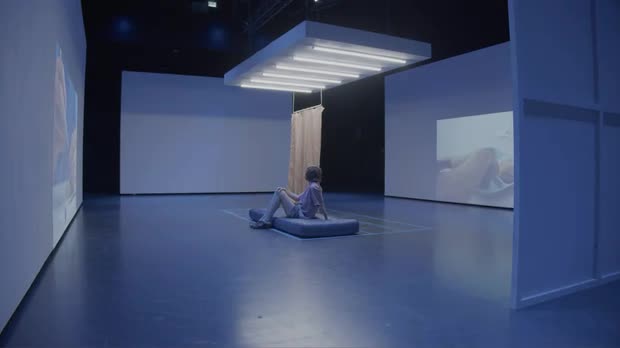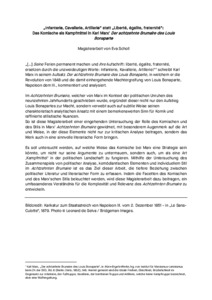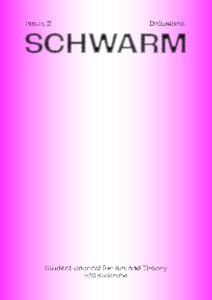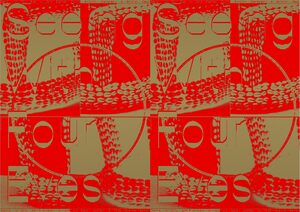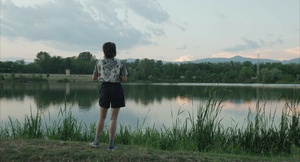Semestereröffnung Sommer 2025
Benachbarte Sets (45)Alle Zusammenhänge anzeigen
Diese Sets wurden den gleichen Sets hinzugefügt wie das ausgewählte Set.
45 Inhalte
- Seite 1 von 4
Disparate Precedents of Display
- Titel
- Disparate Precedents of Display
- Titel (en)
- Disparate Precedents of Display
- Untertitel des Projekts/Werks (en)
- A Footnote
- Autor/in
- Beschreibung (de)
- "Disparate Precedents of Display" untersucht die Art und Weise, wie der Raum auf die Besucher wirkt, und stellt Ausstellungsdesign als eine genuin politische Praxis dar, die auf der Vergangenheit aufbaut und von ihr erbt - von vergangenen Ausstellungen, einflussreichen Ausstellungsgestalter*innen und Konventionen der Präsentation, die in unterschiedlichen politischen Systemen wurzeln.
Zwei Ausstellungen, die vom deutschen Staat in Auftrag gegeben wurden, dienen als Fallstudien. "Gebt mir vier Jahre Zeit" war eine nationalsozialistische Propagandaschau, die 1937 in Berlin stattfand. Sie feierte die Umgestaltung aller Bereiche der Gesellschaft unter der nationalsozialistischen Herrschaft seit der Umsetzung von Adolf Hitlers Vierjahresplan. Einundzwanzig Jahre später beauftragte die Bundesrepublik Deutschland denselben Architekten mit der Gestaltung des deutschen Pavillons auf der Expo '58 in Brüssel. Auf der Weltausstellung hatte der junge Nachfolgestaat zum ersten Mal die Gelegenheit, die kulturellen, wirtschaftlichen und politischen Parameter des nunmehr demokratischen Deutschlands auf internationaler Ebene zu präsentieren. Beide Ausstellungen lassen sich als Repräsentationen staatlicher Macht und politischer Narrative beschreiben - die eine im Namen des Krieges, die andere im Namen der Humanität. Maßgeblich beteiligt an beiden Ausstellungen war Egon Eiermann als Ausstellungsarchitekt.
Performance: Anna K. Seidel
Outside Eye: Caroline Kapp, Manon Haase
Graphikdesign: Mona Mayer
Single line font EE_7475: Barbara Acevedo Strange, Moritz Appich
Coding: Frank Bublitz
Stimme: Liv Rahel Schwenk
Aufzeichnung: Florian Wulff
Video Dokumentation: Mustafa Emin Büyükcoşkun
Photographien: Lizzy Ellbrück
Editorial support: Joyce Moore
Copyediting: George MacBeth
Special Thanks to
Céline Condorelli, Hanne König, Sami Khatib, Lioudmila Voropai,
Julian Warner, Thomas Rustemeyer, Constanze Fischbeck,
Susanne Kriemann, Hans D. Christ und Iris Dressler, Judith Milz,
Christian Becker (Stadtarchiv Oranienburg), Mechthild Ebert (saai),
Janina Capelle, Lydia Kähny, Daniel Lythgoe, Tjark Schönfeld,
Alexander Knoppik, Lena Breitmoser, Sören Göbel, Jule Köpke, Arthur Schuman,
Jana Barthel and Danny Klein.
Gefördert von
Fonds Darstellende Künste (Rechercheförderung)
Rosa Luxemburg Stiftung Baden Württemberg
- "Disparate Precedents of Display" untersucht die Art und Weise, wie der Raum auf die Besucher wirkt, und stellt Ausstellungsdesign als eine genuin politische Praxis dar, die auf der Vergangenheit aufbaut und von ihr erbt - von vergangenen Ausstellungen, einflussreichen Ausstellungsgestalter*innen und Konventionen der Präsentation, die in unterschiedlichen politischen Systemen wurzeln.
- Beschreibung (en)
- "Disparate Precedents of Display" looks at the way space affects visitors, exposing exhibition design as a genuinely political practice, building on and inheriting from the past – from past exhibitions, influential exhibition designers and conventions of display rooted in disparate political systems.
Two exhibitions, commissioned by the German state, serve as case studies. “Gebt mir vier Jahre Zeit” was a National Socialist propaganda show staged in Berlin in 1937. It celebrated the transformation of all sectors of society under National Socialist rule since the implementation of Adolf Hitlers 4-year-plan. Twenty-one years later, the Federal Republic of Germany commissioned the same architect to design the German Pavilion at the Expo ‘58 in Brussels. At the World‘s Fair the young successor state had its first opportunity to present the cultural, economic and political parameters of a now democratic Germany on an international scale. Both shows can be described as representations of state power and political narratives – one in the name of war and one in the name of humanity. Significant contributor to both exhibitions was Egon Eiermann in his role as exhibition architect.
Performance: Anna K. Seidel
Outside Eye: Caroline Kapp, Manon Haase
Graphic Design: Mona Mayer
Single line font EE_7475: Barbara Acevedo Strange, Moritz Appich
Coding: Frank Bublitz
Voice: Liv Rahel Schwenk
Recording: Florian Wulff
Video documentation: Mustafa Emin Büyükcoşkun
Photography: Lizzy Ellbrück
Editorial support: Joyce Moore
Copyediting: George MacBeth
Special Thanks to
Céline Condorelli, Hanne König, Sami Khatib, Lioudmila Voropai,
Julian Warner, Thomas Rustemeyer, Constanze Fischbeck,
Susanne Kriemann, Hans D. Christ und Iris Dressler, Judith Milz,
Christian Becker (Stadtarchiv Oranienburg), Mechthild Ebert (saai),
Janina Capelle, Lydia Kähny, Daniel Lythgoe, Tjark Schönfeld,
Alexander Knoppik, Lena Breitmoser, Sören Göbel, Jule Köpke, Arthur Schuman,
Jana Barthel and Danny Klein.
Funded by
Fonds Darstellende Künste (Rechercheförderung)
Rosa Luxemburg Stiftung Baden Württemberg
- "Disparate Precedents of Display" looks at the way space affects visitors, exposing exhibition design as a genuinely political practice, building on and inheriting from the past – from past exhibitions, influential exhibition designers and conventions of display rooted in disparate political systems.
- Typ des Projekts/Werks
- Schlagworte
- Datierung
- 28.07.2023
- Mitwirkende
- Dank an
- Sprache
- Dauer
- Performance: ca. 30 Minuten
- Ort
- Pavillon an der Brauerstraße
- Stadt
- Land
- Titel
- Disparate Precedents of Display
- Projektleiter/in
- Semester
- Studiengang
- Typ der Abschlussarbeit
- Importiert am
- 28.09.2023
- Übergeordnete Sets
- 3
- Set enthält
- 0 17
Querschnitte des anthropogenen Lagers
- Titel
- Querschnitte des anthropogenen Lagers
- Titel (en)
- Cross-sections of the anthropogenic material stock
- Autor/in
- Beschreibung (de)
- Die Arbeit "Querschnitte des anthropogenen Lagers" setzt sich konzeptionell und praktisch mit der Wiederverwendung von Bauschutt auseinander.
Ein Großteil des in Deutschland aufkommenden Abfalls entsteht im Bausektor in Form von mineralischem Bauschutt und wird meist nur in abgewerteter Form wieder in den Kreislauf eingebracht.
Durch das Besuchen verschiedener Baustellen und Deponien, das Dokumentieren, Sammeln, Sortieren, und Fotografieren der vorgefundenen Materialien und Formen, wurden die noch vorhandenen formalen und optischen Qualitäten des anfallenden Materials analysiert, ergründet und Konzepte entwickelt, wie diese wieder im gleichen Bereich ihres Ursprungs Verwendung finden können.
Dabei wurden durch Querschnitte durch das Material die schon vorhandenen Qualitäten, wie die zylindrische Form von Bohrkernen oder die Terrazzo-Optik im Inneren von Betonbrocken, zum Vorschein gebracht, betont und in einen nutzbaren Kontext gesetzt. Die entstandenen Materialscheiben können durch verschiedene Verbindungstechniken als architektonische Halbzeuge genutzt und in Wandpaneele, Fliesen oder Fassadenelemente eingebracht werden.
- Die Arbeit "Querschnitte des anthropogenen Lagers" setzt sich konzeptionell und praktisch mit der Wiederverwendung von Bauschutt auseinander.
- Beschreibung (en)
- The work "Cross-sections of the anthropogenic material stock" deals conceptually and practically with the reuse of construction waste.
A large part of the waste generated in Germany is produced in the construction sector in the form of mineral building rubble and is usually only recycled in a downgraded form.
By visiting various construction sites and landfills, documenting, collecting, sorting and photographing the materials and shapes found, the remaining formal and visual qualities of the accumulated material were analysed, explored and concepts were developed on how they could be reused in the same area of their origin.
The existing qualities, such as the cylindrical shape of drill cores or the terrazzo look inside chunks of concrete, were brought to light, emphasised and placed in a usable context by making cross-sections through the material. The resulting material discs can be used as architectural semi-finis.
- The work "Cross-sections of the anthropogenic material stock" deals conceptually and practically with the reuse of construction waste.
- Kategorie
- Typ des Projekts/Werks
- Schlagworte
- Datierung
- 30.10.2023
- Titel
- Querschnitte des anthropogenen Lagers
- Projektleiter/in
- Semester
- Studiengang
- Typ der Abschlussarbeit
- Importiert am
- 27.05.2024
- Übergeordnete Sets
- 4
- Set enthält
- 0 23
Oberfläche schwarz/blau/grün
- Titel
- Oberfläche schwarz/blau/grün
- Titel (en)
- Surface Black/Blue/Green
- Autor/in
- Beschreibung (de)
- Bei der 2-Kanal-Videoinstallation „Oberfläche schwarz/blau/grün“ zum Thema Migration werden zwei Situationen betrachtet und einander gegenübergestellt: Migration von einem Land in ein anderes und Migration auf einen anderen Planeten.
- Beschreibung (en)
- The two-channel video installation is about migration, in which two situations are considered and contrasted: migration from one country to another and migration to another planet.
- Kategorie
- Schlagworte
- Titel
- Oberfläche schwarz/blau/grün
- Projektleiter/in
- Semester
- Studiengang
- Typ der Abschlussarbeit
- Importiert am
- 01.08.2024
- Übergeordnete Sets
- 2
- Set enthält
- 1 10
No Mythologies To Follow
- Titel
- No Mythologies To Follow
- Autor/in
- Beschreibung (de)
- "No Mythologies To Follow" zeigt Blumenarrangements für die neun Kulturgüter der Stadt Karlsruhe, die unter Schutz der Haager Konvention stehen.
Die Konvention ist ein völkerrechtlicher Vertrag, der auf Grund der Erfahrungen vorangegangener Weltkriege durch die UNESCO (United Nations Educational, Scientific and Cultural Organization) im Jahr 1954 ins Leben gerufen wurde. Sie stellt (un)bewegliche
Kulturgüter im bewaffneten Konfliktfall unter Schutz. Das heißt, die gelisteten Gebäude dürfen im Kriegsfall von Mitgliedsstaaten nicht geplündert oder attackiert werden, da „jede Schädigung von Kulturgut, gleichgültig welchem Volke es gehört, eine Schädigung des kulturellen Erbes der ganzen Menschheit bedeutet.“ Die Auswahlkriterien für schützenswertes Kulturgut sind dabei nicht immer klar nachzuvollziehen und zeigen, dass Kultur und ihre Bewertung stets an die jeweilige Gesellschaft und ihr Zeitverständnis gebunden ist. Nach der Haager Konvention gibt es Kulturgüter deren „Erhaltung (…) für alle Völker der Welt von großer Bedeutung ist.“
Die Blumenarrangements werden in der Ausstellung zu Akteuren, die für einen anderen Umgang mit Kulturgut stehen. Durch sie wird Vergänglichkeit artikuliert.
Zitate aus: Konvention zum Schutz von Kulturgut bei bewaffneten Konflikten – Haager Konvention vom 14. Mai 1954.
- "No Mythologies To Follow" zeigt Blumenarrangements für die neun Kulturgüter der Stadt Karlsruhe, die unter Schutz der Haager Konvention stehen.
- Beschreibung (en)
- “No Mythologies To Follow” shows flower arrangements for the nine cultural assets of the city of Karlsruhe that are protected by the Hague Convention.
The Convention is a treaty under international law that was brought into being by UNESCO (United Nations Educational, Scientific and Cultural Organization) in 1954 as a result of the experiences of previous world wars. It provides (in)movable
cultural property under protection in the event of armed conflict. This means that the listed buildings may not be looted or attacked by member states in the event of war, as “any damage to cultural property, regardless of the people to whom it belongs, means damage to the cultural heritage of all mankind.” The selection criteria for cultural property worthy of protection are not always clear and show that culture and its evaluation are always linked to the respective society and its understanding of the times.
is bound to the respective society and its understanding of time. According to the Hague Convention, there are cultural assets whose “preservation (...) is of great importance to all peoples of the world.”
In the exhibition, the flower arrangements become actors that stand for a different approach to cultural assets. They articulate transience.
Quotes from: Convention for the Protection of Cultural Property in the Event of Armed Conflict - Hague Convention of May 14, 1954.
- “No Mythologies To Follow” shows flower arrangements for the nine cultural assets of the city of Karlsruhe that are protected by the Hague Convention.
- Kategorie
- Typ des Projekts/Werks
- Schlagworte
- Mitwirkende
- Dank an
- Harald Bogdan
- Michael Clegg
- Anja Dorn
- Pham Minh Duc
- Friedemann Dupelius
- Lotte Effinger
- Susan Funk
- Hasan Halilovic
- Korbinian Herlein
- Erika Hoth
- Katharina Hoth
- Burkhard Hoth
- Achim Kaltwasser
- Wilfried Kuehn
- Barbara Kuon
- Gisbert Laaber
- Armin Linke
- Henrike Mall
- Isabel Mehl
- Nicolas Rauch
- Gerald Reinhardt
- Christiane Riedel
- Thomas Rustemeyer
- Martina Stern
- Felicitas Wetzel
- Tobias Wootton
- Emre Yilmaz
- Ort: Institution
- Ort
- Ausstellungsraum EG
- Stadt
- Beteiligte Institution(en)
- Titel
- No Mythologies To Follow
- Semester
- Studiengang
- Typ der Abschlussarbeit
- Importiert am
- 30.07.2024
- Übergeordnete Sets
- 2
- Set enthält
- 6 6
Ungeordnete Zustände
- Titel
- Ungeordnete Zustände
- Titel (en)
- Disorderly Conditions
- Untertitel
- Abtrag I Fragmentierung I Zerfall I Austrag I Verschwinden: Kleingärten an der Stuttgarter Straße Karlsruhe
- Untertitel des Projekts/Werks (en)
- Removal I Fragmentation I Decay I Dismantling I Disappearance: Allotment gardens on Stuttgarter Straße in Karlsruhe
- Autor/in
- Beschreibung (de)
- Die Ausstellung "Ungeordnete Zustände" erzählt in unterschiedlichen Strängen von der Auflösung der Kleingärten an der Stuttgarter Straße in Karlsruhe. Leonie Mühlen beobachtete diese Bewegungen, dokumentierte sie und nahm selbst daran teil. Die gezeigte Sammlung ist ein Versuch den Ort zu begreifen und zu konservieren. Eben diesen Ort im Abbruch, der in seiner Unordnung und seinem Ungehorsam Refugium für viele Dinge und Wesen war.
- Beschreibung (en)
- The exhibition "Ungeordnete Zustände" tells the story of the dissolution of the allotment gardens on Stuttgarter Straße in Karlsruhe in various strands. Leonie Mühlen observed these movements, documented them and took part in them herself. The collection on display is an attempt to understand and preserve the place. Precisely this place in demolition, which in its disorder and disobedience was a refuge for many things and beings.
- Kategorie
- Schlagworte
- Datierung
- 09.06.2021 - 27.06.2021
- Mitwirkende
- Ort: Institution
- Ort
- Luisenstraße 32
- Stadt
- Land
- Titel
- Ungeordnete Zustände
- Projektleiter/in
- Semester
- Studiengang
- Typ der Abschlussarbeit
- Importiert am
- 17.06.2024
- Übergeordnete Sets
- 2
- Set enthält
- 2 17
Die Kehrseite der Erinnerungskultur
- Titel
- Die Kehrseite der Erinnerungskultur
- Titel (en)
- The Other Side of Erinnerungskultur
- Untertitel
- Eine Kritik des Verhältnisses zur Vergangenheit im deutschen Gedenk- und im globalen Menschenrechtsdiskurs
- Autor/in
- Beschreibung (de)
- In dieser Arbeit setze ich mich mit unterschiedlichen Geschichtsbegriffen auseinander. Dafür dienen mir die Diskussionen um die deutsche Erinnerungskultur als Einstiegspunkt. Das Ziel ist es allerdings nicht, unmittelbar in die polarisierte Debatte einzugreifen. Stattdessen richtet sich der Fokus auf das ideologische Fundament, das verschiedenen Formen, mit der eigenen Geschichte umzugehen, zugrunde liegt. Den theoretischen roten Faden bildet das Werk "After Evil" des Philosophen Robert Meister. Darin kritisiert er die Haltung, die Vergangenheit zwar als schlimm zu verurteilen, aber gleichzeitig auch als abgetrennt von der Gegenwart zu betrachten. Herausgearbeitet werden die Argumente unter anderem anhand von Filmen von Alexander Kluge und Harun Farocki.
- Beschreibung (en)
- In this work, I examine different concepts of history. The discussions surrounding the German culture of remembrance serve as my starting point. However, the aim is not to intervene directly in the polarized debate. Instead, the focus is on the ideological foundations that underlie different ways of dealing with one's own history. The work “After Evil” by philosopher Robert Meister forms the theoretical leitmotif. In it, he criticizes the position of condemning the past as evil, but treating it at the same as something that is separated from the present. The arguments are elaborated on the basis of films by Alexander Kluge and Harun Farocki, among others.
- In this work, I examine different concepts of history. The discussions surrounding the German culture of remembrance serve as my starting point. However, the aim is not to intervene directly in the polarized debate. Instead, the focus is on the ideological foundations that underlie different ways of dealing with one's own history. The work “After Evil” by philosopher Robert Meister forms the theoretical leitmotif. In it, he criticizes the position of condemning the past as evil, but treating it at the same as something that is separated from the present. The arguments are elaborated on the basis of films by Alexander Kluge and Harun Farocki, among others.
- Kategorie
- Typ des Projekts/Werks
- Schlagworte
- Datierung
- 31.10.2023
- Sprache
- Bemerkungen
- Eine kondensierte Fassung des Textes wurde von "Umbau" veröffentlicht: https://umbau.hfg-karlsruhe.de/posts/die-kehrseite…
- Titel
- Die Kehrseite der Erinnerungskultur
- Projektleiter/in
- Semester
- Studiengang
- Typ der Abschlussarbeit
- Importiert am
- 07.06.2024
- Übergeordnete Sets
- 3
- Set enthält
- 0 2
7QM
- Titel
- 7QM
- Titel (en)
- 7sqm - inside views
- Untertitel
- Innen(an)sichten
- Autor/in
- Beschreibung (de)
- Was passiert, wenn Individuen in engen, geschlossenen Räumen mit kaum persönlicher, sondern standardisierter, fest verankerter, textilloser Ausstattung leben, in denen sie einer permanenten Überwachung und Kontrolle sowie streng geregelten Tagesabläufen ausgesetzt sind?
Mascha Dilger untersucht die Parameter sanktionierender Räume: Besuche in unterschiedlichen Justizvollzugsanstalten und Interviews mit ehemaligen Inhaftierten werden in der Rauminstallation 7qm - Innen(an)sichten verarbeitet. Realitäten eines vor der Gesellschaft verborgenen und von ihr verdrängten Ortes werden offengelegt.
Die Arbeit beleuchtet, wie aus einem fremdbestimmten, rasterartigen Alltag einer totalen Institution, Versuche der geistigen Flucht und der Selbstbestimmtheit hervorgehen können. Es werden ortsspezifische und subkulturelle Erscheinungsformen betrachtet, die als Überlebensstrategien zu verstehen sind.
- Was passiert, wenn Individuen in engen, geschlossenen Räumen mit kaum persönlicher, sondern standardisierter, fest verankerter, textilloser Ausstattung leben, in denen sie einer permanenten Überwachung und Kontrolle sowie streng geregelten Tagesabläufen ausgesetzt sind?
- Beschreibung (en)
- What happens when individuals live in narrow, confined spaces with hardly any personal but standardized, firmly anchored, textile-less furnishings, in which they are exposed to permanent surveillance and control as well as strictly regulated daily routines?
Mascha Dilger investigates the parameters of sanctioning spaces: visits to various prisons and interviews with former inmates are processed in the spatial installation "7qm - Innen(an)sichten". Realities of a place hidden from society are revealed.
The work illuminates how attempts of mental escape and self-determination can emerge from the grid-like everyday life of a total institution. Site-specific and subcultural manifestations are considered, which are to be understood as survival strategies.
- What happens when individuals live in narrow, confined spaces with hardly any personal but standardized, firmly anchored, textile-less furnishings, in which they are exposed to permanent surveillance and control as well as strictly regulated daily routines?
- Kategorie
- Typ des Projekts/Werks
- Schlagworte
- Datierung
- 11.07.2023 - 12.07.2023
- Mitwirkende
- Dank an
- Zaur Ahlimanov
- Phillip Banian
- Jeremias Beckford
- Sandra Blatterer
- Barbara Bohnen
- Matthias Bruhn
- Richard Brunner
- Céline Condorelli
- Hannah Cooke
- Jaya Demmer
- Lina Determann
- Alfred Dilger
- Nicola Dilger
- Susanne Dilger
- Manfred Döpke
- Nina Eberle
- Kerstin Eisenmenger
- Constanze Fischbeck
- Ebba Fransén Waldhör
- Laura Haak
- Uwe Habel
- Laurine Haller
- Igor Hardt
- Lina Höhne
- Lovis Iglinski
- Martina Kaltenbrunner
- Tobias Keilbach
- Alexander Knoppik
- Katja Koch
- Mikail Kolbasar
- Hanne König
- Susanne Kriemann
- Claudia Kröhl
- Barbara Kuon
- Alexia Metge
- Paulina Mimberg
- Ilja Morgenstern
- Leonie Mühlen
- Minh Anh Nguyen
- Luise Peschko
- Vlado Petrovic
- Milena Petrovic
- Tibor Pilz
- Christian Platz
- Paul Platz
- Waldemar Präg
- Corinne Riepert
- Thomas Rustemeyer
- Sebastian Schäfer
- Max Schäffer
- Philipp Schell
- Susanne Schmitt
- Mischa Schneider
- Waldemar Schwab
- Henriette Schwabe (Jette Schwabe)
- Manuel Sékou
- Alexander Theis
- Alexander Thelen
- Lisa Tölle
- Jan Tölle
- Lioudmila Voropai
- Badaue
- Initiative „Faites Votre Jeu!“
- AStA
- JVA Bühl
- Exit - Enter Life e.V.
- JVA Mannheim
- Sprache
- Material
- Ort: Institution
- Ort
- im großen Studio
- Stadt
- Land
- Beteiligte Institution(en)
- Titel
- 7QM
- Projektleiter/in
- Semester
- Studiengang
- Typ der Abschlussarbeit
- Importiert am
- 26.07.2023
- Übergeordnete Sets
- 3
- Set enthält
- 4 2
„Infanterie, Cavallerie, Artillerie“ statt „Liberté, égalite, fraternité“: Das Komische als Kampfmittel in Karl Marx' "Der achtzehnte Brumaire des Louis Bonaparte"
- Titel
- „Infanterie, Cavallerie, Artillerie“ statt „Liberté, égalite, fraternité“: Das Komische als Kampfmittel in Karl Marx' "Der achtzehnte Brumaire des Louis Bonaparte"
- Autor/in
- Beschreibung (de)
- Im Aufsatz „Der achtzehnte Brumaire des Louis Bonaparte“, welcher von Karl Marx im Kontext der politischen Unruhen des neunzehnten Jahrhunderts geschrieben wurde, ergründet dieser nicht nur den Aufstieg Louis Bonapartes zur Macht, sondern verwebt auch auf subtile Weise seinen charakteristisch analytischen Ansatz mit einem bemerkenswerten Sinn für Komik und raffinierte stilistische Nuancen.
So ist diese Magisterarbeit einer eingehenden Untersuchung der Rolle des Komischen und des Stils in Marx' „Achtzehnten Brumaire“ gewidmet, mit besonderem Augenmerk auf die Art und Weise, in der diese Elemente nicht nur zur kritischen Analyse beitragen, sondern das Werk auch in eine sinnvolle literarische Form bringen.
Es soll untersucht werden, auf welche Weise das Komische bei Marx eine Strategie sein könnte, um nicht nur seine Argumente zu untermauern, sondern auch, um als eine Art ‚Kampfmittel‘ in der politischen Landschaft zu fungieren. Mithilfe der Untersuchung des Zusammenspiels von politischer Analyse, komödiantischen Elementen und individuellem Stil im „Achtzehnten Brumaire“ ist es das Ziel dieser Arbeit, die tiefere Beziehung zwischen politischer Literatur und literarischer Form zu erfassen. Indem die Facetten des Komischen und des Marx'schen Stils beleuchtet werden, wird diese Magisterarbeit dazu beitragen, ein umfassenderes Verständnis für die Komplexität und Relevanz des „Achtzehnten Brumaire“ zu entwickeln.
- Im Aufsatz „Der achtzehnte Brumaire des Louis Bonaparte“, welcher von Karl Marx im Kontext der politischen Unruhen des neunzehnten Jahrhunderts geschrieben wurde, ergründet dieser nicht nur den Aufstieg Louis Bonapartes zur Macht, sondern verwebt auch auf subtile Weise seinen charakteristisch analytischen Ansatz mit einem bemerkenswerten Sinn für Komik und raffinierte stilistische Nuancen.
- Beschreibung (en)
- In the essay “The Eighteenth Brumaire of Louis Bonaparte”, written by Karl Marx in the context of the political turmoil of the nineteenth century, he not only explores Louis Bonaparte's rise to power but also subtly interweaves his characteristically analytical approach with a remarkable sense of comedy and refined stylistic nuance.
Thus, this master thesis is dedicated to an in-depth examination of the role of comedy and style in Marx's “Eighteenth Brumaire”, with particular attention to how these elements not only contribute to critical analysis but also give the work a meaningful literary form.
It will examine how the comic might be a strategy for Marx not only to support his arguments but also to function as a kind of 'means of struggle' in the political landscape. By examining the interplay of political analysis, comedic elements, and individual style in the “Eighteenth Brumaire”, this thesis aims to grasp the deeper relationship between political literature and literary form. By highlighting the facets of comedy and Marx's style, this thesis will help to develop a more comprehensive understanding of the complexity and relevance of the “Eighteenth Brumaire”.
- In the essay “The Eighteenth Brumaire of Louis Bonaparte”, written by Karl Marx in the context of the political turmoil of the nineteenth century, he not only explores Louis Bonaparte's rise to power but also subtly interweaves his characteristically analytical approach with a remarkable sense of comedy and refined stylistic nuance.
- Kategorie
- Typ des Projekts/Werks
- Datierung
- 31.08.2023
- Sprache
- Titel
- „Infanterie, Cavallerie, Artillerie“ statt „Liberté, égalite, fraternité“: Das Komische als Kampfmittel in Karl Marx' "Der achtzehnte Brumaire des Louis Bonaparte"
- Projektleiter/in
- Semester
- Studiengang
- Typ der Abschlussarbeit
- Importiert am
- 31.05.2024
- Übergeordnete Sets
- 3
- Set enthält
- 0 2
Seeing With Four Eyes
- Titel
- Seeing With Four Eyes
- Titel (en)
- Seeing With Four Eyes
- Autor/in
- Beschreibung (de)
- Die Ausstellung "Seeing With Four Eyes" verfolgt die Objektbiografie der Statue Ngonnso' aus Kamerun durch verschiedene geografische, zeitliche und institutionelle Kontexte. Dieser erste Satz ist bereits fehlerhaft. Ist Statue überhaupt ein angemessener Begriff, um eine Figur zu beschreiben, die für die einen ein Lebewesen darstellt, während andere sie lediglich als Beispiel für materielle Kultur betrachten? Und ist Biografie der richtige Begriff, um das Leben eines Artefakts zu beschreiben? Ist sie an ihr materielles Wesen gebunden oder existiert sie schon lange bevor sie aus Holz geschnitzt wurde und lange nachdem sie von Termiten gefressen wurde oder in einem brennenden Museum verloren ging? In dem Bestreben, mehr über Ngonnso' zu erfahren, beschloss ich, sie bei ihrem Namen zu nennen und damit nicht vorzuschreiben, was sie ist. Ich habe versucht, die Fragmente einer Geschichte zu sammeln, die sich nicht zu einem Ganzen zusammenfügen lassen. Ich verfolgte Fäden, die bis zur Entstehungszeit zurückreichen, zu Strafexpeditionen und Kriegshandlungen des deutschen Kolonialreichs, zu Kulturfesten in Kamerun und Europa und zu einem Museum, das versucht, mit seiner Sammlung zurechtzukommen. Ich habe mit Menschen gesprochen, die sich entweder mit Ngonnso' selbst oder mit den Kampagnen, nationalen Gesetzen und der Politik beschäftigt haben, die sie beeinflusst haben und weiterhin beeinflussen. Ngonnso' befindet sich in einem Schwebezustand: Sie wird im Frühjahr 2019 von einem Museumsdepot am Rande Berlins in eine neue Museumseinrichtung im Stadtzentrum transportiert und damit erneut von einem gelagerten Objekt in ein Ausstellungsobjekt verwandelt. Zugleich ist sie Gegenstand laufender Restitutionsverhandlungen zwischen dem Oberhäuptling des Königreichs Nso', Fon Sehm Mbinglo I, dem Staat Kamerun, dem Ethnologischen Museum Berlin und dem deutschen Staat. "Seeing With Four Eyes" bietet einen Raum, um über diese Einheit in ihren vielfältigen und widersprüchlichen Dimensionen zu reflektieren.
- Beschreibung (en)
- The exhibition "Seeing With Four Eyes" follows the object biography of the statue Ngonnso’ from Cameroon through different geographical, temporal and institutional contexts. This first sentence is already flawed. Is statue even an adequate term to describe a figure that represents a living being to some people, while others merely see it as an example of material culture? And is biography the right term to describe the life of an artifact? Is it bound to its material being or does it exist well before it is carved out of wood and long after it is eaten by termites or lost in a burning museum? In the endeavour to learn more about Ngonnso’, I decided to call her by her name, thereby not predefining what she is. I tried to gather the fragments of a story that do not form a whole. I followed threads that go back to the time of creation, to punitive expeditions and acts of war carried out by the German colonial empire, cultural festivals in Cameroon and Europe, and to a museum trying to come to terms with its collection. I talked to people who have engaged either with Ngonnso’ herself or with the campaigns, national laws, and politics that have influenced and continue to influence her. Ngonnso’ is in a state of limbo: she will be transported from a museum depot in the outskirts of Berlin to a new museum institution in the city centre in the spring of 2019, once again being transformed from a stored object into an exhibition object. At the same time, she is subject of ongoing restitution negotiations between the paramount chief of the kingdom Nso’, Fon Sehm Mbinglo I, the state of Cameroon, the Ethnological Museum Berlin and the German state. "Seeing With Four Eyes" offers a space to reflect upon this entity through its multiple and contradictory dimensions.
- Typ des Projekts/Werks
- Schlagworte
- Datierung
- 14.11.2018 - 16.11.2018
- Sprache
- Ort: Institution
- Ort
- Lichtbrücke
- Stadt
- Land
- Titel
- Seeing With Four Eyes
- Projektleiter/in
- Semester
- Studiengang
- Typ der Abschlussarbeit
- Importiert am
- 24.05.2023
- Übergeordnete Sets
- 2
- Set enthält
- 0 5
A Factor of Evolution - Triangel Studio
- Titel
- A Factor of Evolution - Triangel Studio
- Titel (en)
- A Factor of Evolution - Triangel Studio
- Autor/in
- Beschreibung (en)
- We live in times of high competition. Survival of the fittest is the omnipresent motto in most fields of human action, especially in the western world. This philosophy was only established about 200 years ago and manifested by Charles Darwin and especially the Social Darwinists at the end of the 19th century. They believed that according to a law of nature, only the physically strongest and most aggressive individuals and species would survive in the struggle for life. Many Social Darwinists justified therefore capitalism and racism with devastating consequences in the coming decades until nowadays.
Peter Kropotkin is attempting in his philosophical work Mutual Aid: A Factor of Evolution (1902) to dismantle their arguments and based on numerous observations of zoologists and anthropologists, he proves, that the fittest species are the most sociable ones and that sociability develops intelligence, which is the most powerful arm in the struggle for survival. This includes insects, animals and humans. Higher moral sentiments and compassion is also essential for survival in all societies.
The ritual burning of sage in nature should help to cleanse the negative energy of social darwinism in our world and make room for a more cooperative society, that will secure the well-being of all members, even the most weak ones and furthermore facilitate a more sustainable, safe and content society.
- We live in times of high competition. Survival of the fittest is the omnipresent motto in most fields of human action, especially in the western world. This philosophy was only established about 200 years ago and manifested by Charles Darwin and especially the Social Darwinists at the end of the 19th century. They believed that according to a law of nature, only the physically strongest and most aggressive individuals and species would survive in the struggle for life. Many Social Darwinists justified therefore capitalism and racism with devastating consequences in the coming decades until nowadays.
- Typ des Projekts/Werks
- Schlagworte
- Datierung
- 07.06.2024
- Mitwirkende
- Beteiligte Institution(en)
- Titel
- A Factor of Evolution - Triangel Studio
- Importiert am
- 05.06.2024
- Übergeordnete Sets
- 1
- Set enthält
- 0 14
Geography is destiny
- Titel
- Geography is destiny
- Titel (en)
- Geography is destiny
- Autor/in
- Beschreibung (de)
- In einem bulgarischen Tal, in dem die Produktion von Rosen und Waffen das Klima des Lebensraums bestimmt, begibt sich die Autorin des Films auf eine Identitätssuche, eine Reise entlang der bipolaren, psychogeografischen Realität ihres Geburtsorts.
- Beschreibung (en)
- In a Bulgarian valley where the production of roses and weapons determines the climate of the living environment, the film’s author takes off on an identity quest, a journey along the bipolar, psychogeographic reality of her birthplace.
- Typ des Projekts/Werks
- Schlagworte
- Datierung
- 01.09.2023
- Mitwirkende
- Dank an
- Sprache
- Untertitel (Film)
- Technik/Verfahren/Formate
- dcp
- Dauer
- 75min.
- Ort: Institution
- Ort
- Blauer Salon
- Stadt
- Land
- Bemerkungen
- The film copy will be archived at the Film Archiv of HFG. Current contact person as per 2023 - Philip Lawall
- Titel
- Geography is destiny
- Projektleiter/in
- Semester
- Studiengang
- Typ der Abschlussarbeit
- Importiert am
- 26.09.2023
- Übergeordnete Sets
- 2
- Set enthält
- 0 3
